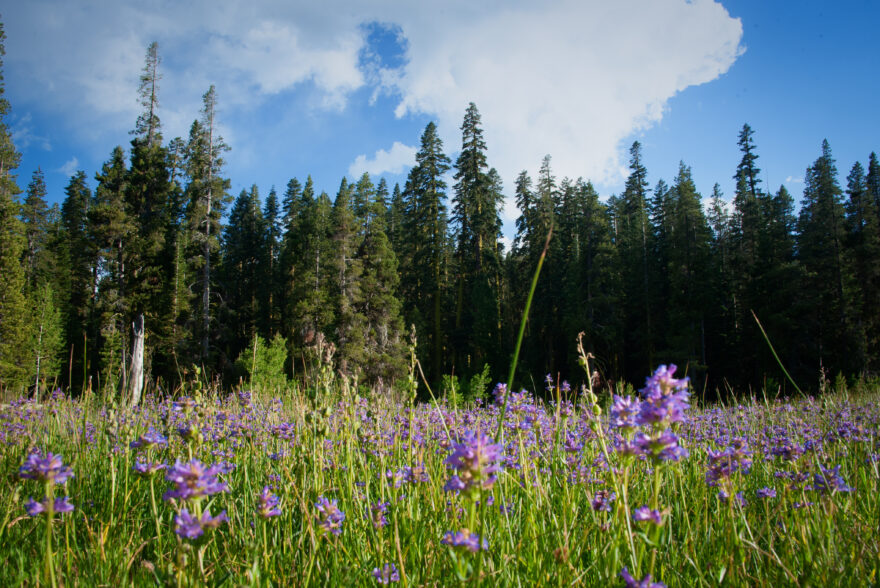Meadow Restoration and Aspen Stand Regeneration for Forest Health


Both aspen regeneration and meadow restoration yield multiple, critical benefits to ecosystems and communities ranging from soil quality to water storage to biodiversity protection. Blue Forest is committed to supporting the benefits of holistic landscape restoration.
Written by: Annapurna Holtzapple, Project Associate
At Blue Forest, we work to increase the pace and scale of holistic restoration projects. Reducing the risk of catastrophic wildfire is a critical benefit that often arises from our work, but it is only one benefit of projects that incorporate many treatment activities to restore overall ecosystem health, strengthen various functions for biodiversity and resilience, and protect nature’s benefits to people.
For example, many forest health projects incorporate meadow restoration and aspen stand regeneration. Often found together in seasonally wet or riparian niches, aspen stands and meadow habitats both are important actors for biodiversity, forest food chains, and water storage. The treatments that support aspen and meadow resilience and re-establishment bolster the ecosystem as a whole and provide benefits to downstream human communities.
The aspen tree, Populus tremuloides (also known as the quaking aspen), is a fascinating and beautiful species. Aspens are deciduous, broadleaf trees that do not go dormant over the winter. While their leaves do change color and fall off in colder months, these trees have a photosynthetic green bark layer on their trunks. This special layer lives through the winter months and acts as an important food source and a key piece of forested food webs when other food sources are covered in snow or seasonally unavailable. Elk and deer primarily feed on this special aspen layer in snowy months, and year-round aspens provide food for various wildlife, such as bears, beaver, moose, grouse, and rodents. In addition, an aspen is the largest organism in the world, and the species has amazing cloning and resprouting capabilities.
In recent years, various environmental pressures have resulted in a major dieback of aspen. These trees are susceptible to drought and high temperatures, and recent conditions have increased disease spread and beetle attacks. Additionally, wildlife losses and smaller populations of predators in these ecosystems have increased numbers of deer and elk, resulting in even more feeding on young trees. This increased feeding can prevent young aspen stands from reaching maturity and disrupt regeneration cycles.
Forest management can include treatments like strategically placed fencing that promote aspen regeneration. By installing fencing around these young trees and protecting them when they are small, juvenile aspen trees are allowed to grow to maturity and become healthy and established enough to survive feeding events from wildlife.
Aspen stands provide many ecosystem benefits, including increasing the quality of soil by creating pores in the soil structure so water and air can pass through and storing nutrients and moisture, particularly through the summer months when there is less precipitation. These important benefits further support plant community development.
In addition to being important biodiversity and food web actors, aspen provide valuable ecosystem services to human communities. In addition to storing carbon (like all trees) and having medicinal properties (aspen contain salicylates, a compound similar to aspirin), aspen regulate water quantity in the headwaters. Aspen trees have a unique root type, distinct from that of conifer trees, which allows them to store water. This increased storage can help to prevent flooding and slow flows from snowmelt. As such, aspen trees regulate the water cycle, protect watersheds, and provide seasonally important flow to the streams and rivers that support downstream human communities.
Meadows, which often have aspen trees in or nearby them, are typically biodiversity hotspots and provide important “edge” habitat. Edge habitats are characterized by a boundary where two different ecosystem types meet, such as a meadow and a forest or a grassland and shrubland. These edges often have particular microclimates, increased plant richness, and various growth forms. In turn, unique animal species can live there. This abundance also means that various types of wildlife visit edge habitats to feed on food types that live in both habitats.
Meadows are also critical to water storage and are often thought of as “sponges” by ecologists and foresters. They receive water flowing from surrounding slopes and filter sediment that it may be carrying. As a result, the runoff traveling through the watershed is cleaner and higher quality once it passes through a meadow. Meadows also influence the soil structure and pore size, allowing them to store more water than surrounding areas and providing gradual flow to streams. This is extremely important for flood risk reduction, which will be critical in many parts of the Western U.S. as this year’s record-breaking snowpack begins to melt. This function of meadows is also important in dry periods, as the slow release of water into streams and rivers provides an important continuous supply over dry summers. This storage capacity is critical for human communities in places such as California, where summers are dry but summertime water demand is high.
While most discussions of the negative impacts of legacy fire suppression focus on increased density in forest stands and vulnerable conditions from heavy fuel loading, a lack of fire has also increased conifer trees in non-native locations such as meadows. This expansion of conifer growth is known as “conifer encroachment” and has significant impacts on water storage. When the vegetative community in meadows shifts towards more trees, the increased water demand from the trees can lead to meadows drying out. As they become drier, they are less able to store water and support their unique plant communities, decreasing both biodiversity and food web services and water storage benefits. Restoration treatments like thinning and removing inappropriate trees, such as conifers, can help to restore meadows to their full functional capacity.
Both aspen regeneration and meadow restoration yield multiple, critical benefits to ecosystems and communities ranging from soil quality to water storage to biodiversity protection. Blue Forest is committed to supporting the benefits of holistic landscape restoration.